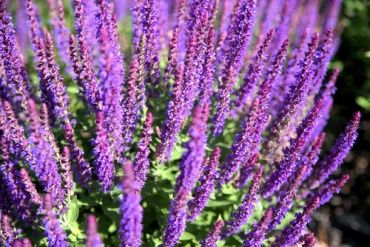
Where would our gardens be without summer salvias? With close to 900 different species, from colourful bedding salvias to hardy perennials, they’re a must-have in summer gardens.
Salvias come in all shapes and sizes, from compact bedding varieties perfect for containers to giants like the striking Salvia ‘Amistad’, reaching 1.2m (4ft) tall. Some, like Salvia ‘Hot Lips’, have intensely fragrant leaves. There are evergreen shrubby varieties, like Salvia officinalis, better known as culinary sage, and even variegated varieties like Salvia ‘Tricolor’ with pink, white, and green variegated leaves.
Where to grow Salvias
All Salvias like the sun and prefer well-drained soil. Most will grow well on poor soils; the only land they don’t do well in is heavy clay. They’re ideal for coastal gardens and cope well with drought conditions. With their spires of vibrantly coloured flowers from mid-summer onwards, Salvias look spectacular combined with grasses in prairie planting schemes or adding a splash of colour in a sunny border. Bees and butterflies love the flowers.
How to care for Salvias
Salvias don’t need much looking after. Water container-planted salvias regularly, feed fortnightly with a high potash feed to promote flower production and remove faded flowers. Salvias grown in the ground don’t need feeding, but deadheading will help to extend the flowering period.
Bedding salvias are usually grown as annuals, and pulled up and composted in autumn once they have finished flowering. Half-hardy or tender salvias will need winter protection. In mild areas, a thick mulch may be enough to get them through the cold months, but in icy regions, they’re best grown in containers and moved into a frost-free greenhouse over winter.
Hardy perennial Salvias can be cut back to ground level in autumn or spring, but the tender varieties should be left until spring. Shrubby varieties can also be lightly pruned in spring to remove any dead or spindly growth. Cut back culinary sage in spring for a fresh crop of tasty young leaves to cook with, but avoid cutting back into old wood.
Six great Salvias to grow
-
Salvia nemorosa ‘Caradonna’ – a hardy perennial variety with deep purple flower spikes in summer.
-
Salvia ‘Amistad’ – a spectacular hardy perennial Salvia, 1.2m (4ft) tall, with nearly-black buds opening into deep blue flowers from mid-summer well into autumn.
-
Salvia microphylla ‘Hot Lips’ – a shrubby evergreen variety with vivid red and white flowers and sensationally fragrant foliage.
-
Salvia farinacea ‘Victoria’ – one of the most popular bedding Salvias, just 40cm (16in) tall with spires of deep blue flowers.
-
Salvia elegans (pineapple sage) – tender perennial Salvia with pineapple-scented leaves and spires of bright red flowers in late summer. Best in a conservatory or greenhouse.
-
Salvia officinalis ‘Purpurascens’ - an evergreen culinary variety that also looks great in the border, with leaves that take on a purplish sheen as they mature.
If you’re looking for Salvias or other summer-flowering plants to brighten up your garden, you’ll find them in our centre. Visit us now to see our high summer ranges.




